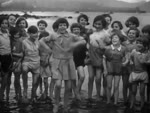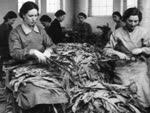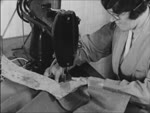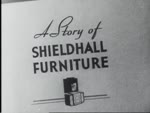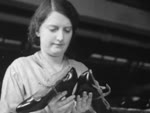BRUNTON'S WIRE AND ROPE WORKS, MUSSELBURGH
Full length video
Please read Understanding catalogue records for help interpreting this information and Using footage for more information about accessing this film.
Title: BRUNTON'S WIRE AND ROPE WORKS, MUSSELBURGH
Reference number: 0438
Date: 1930*
Sponsor: Brunton's (Musselburgh) Limited
Production company: Jay's Screen Service
Sound: silent
Original format: 35mm
Colour: bw
Fiction: non-fiction
Running time: 39.50 mins
Description: The processes involved in the manufacturing of wire rope at Brunton's Wire and Rope Works, Musselburgh.
Shotlist:
REEL I
Credits (.23); Showing the manufacture of wire ropes from the steel billet. Aerial view of plant at Musselburgh, Scotland. Various shots across roof of plant (.46); The raw material enters the works in the form of steel billets 2" to 4" square. Shot of two men unloading the billets from cart (1.01); These billets are charged into a furnace and heated to a temperature of about 1100 (degrees) Centigrade. Shot of men feeding billets into furnace, two men to each billet (1.39); The heated billets are now rolled into wire rods from 3/4" to 3/16" diameter, according to size of wire to be produced. Shots of billets being removed from the furnace and immediately being fed into a machine with a "roller" system which gradually thins and stretches the wire as it is ejected. Shots as the process is repeated several times. The wire is coiled up (3.53); Before these rods can be drawn into wire it is essential to remove all scale. This is accomplished by immersion in acid. Shots of the coils being dipped into acid bath (4.24); When clean the rods are removed, washed with water at a high pressure, dipped in hot lime to prevent rusting and dried in an oven. Shots of coils of wire being removed from baths and then pushed by trolley into drying ovens (5.15); The cleaned rods are now drawn to the pre-determined gauge for heat treatment (patenting). Shots of rods being unwound on a machine (5.36); The wire is conveyed to the heat treatment department where it is pulled through a gas heated furnace. Shot of same (6.36); The temperature of the furnace is recorded by a purometer (6.44); The correct structure is obtained by quenching. Shot of man shoveling ash-like substance around the machine (7.03); The temperature of the quenching is controlled by purometer. Shot of the purometer and then general shots of the wire on a series of rollers (7.53); The heat treated wire is examined by microscope to ensure that the correct structure has been obtained. Shot of man peering through microscope. Enlargement of specimen - "Before and After Heat" (8.22).
REEL II
No credits. This heat treated wire is again cleaned in acid before final drawing. (.07)); The wire is drawn to the finished gauge (.12); Shot of man at bench working with wire using various tools and machinery and finally winding it onto a metal drum and then removing it from the drum to repeat process again (2.43); The fine wire is drawn continuously, ie. several passes in one operation (2.50); Shot of woman working with wire bobbins on same machine. Wire is pulled through several mechanisms from one bobbin on same machine. Wire is pulled through several mechanisms from one bobbin to another (5.11); Shot of man galvanising wire by pulling it through liquid (mercury?) and then winding it up (6.17); An important operation is the testing of each coil for diameter, ductility (bending and torsion tests) and tensile strength. Man measures wire's diameter, another measures torsion and strength (7.31); The manufacture of wire rope. The wire is wound on bobbins for the production of strands composing the ropes (8.43); End of Part 2 (8.45)
REEL III
No credits. The reels when wound are fitted into machines which spin the wire into strands. Women work separate strands together and then wire rope is would onto large drum (4.00); The fibre cores of rope are lubircated by impregnating in vacuo with a suitable lubricant. Fibre cores locked in large airtight metal "barrel" and sealed (4.30); Barrels are opened again and the contents removed (5.02); The strands are laid round the fibre core to form the finished rope. This operation is termed "closing". The machine on the left of the picture is used for the manufacture of lock coil rope. That on the right is capable of producing a flattened strand of rope in one continuous length of 30 tons in weight (the largest of its kind in Britain) (5.26); Shot of two machines in operation (8.29); Full drum of wire rope is removed by crane (8.48); The finished ropes are dipped into a preservative lubricant for protection against corrosion. Drums of wire are treated with lubricant (9.25)
REEL IV
No credits. Incidental operations such as splicing and socketing wire ropes. Man splices and sockets rope by hand using various tools (3.45); Finished ropes and fittings showing "ordinary", "langs" and trulay" ropes. Various types of end finish to ropes and their cross-sections (4.20); All finished wire ropes are tested to destruction and a certificate issued stating the actual breaking load. Wire rope is pulled apart, breaking load measured and certificate [blurred] (5.28); Drums of wire rope loaded onto truck and taken away (6.42); From billet to wire rope showing steel billets, wire rod, wire and finished rope. Shots of same (7.03); Factory whistle blows, gates open and hundreds of workers, some running, leave after yet another day's work (7.47); The End (7.48)

